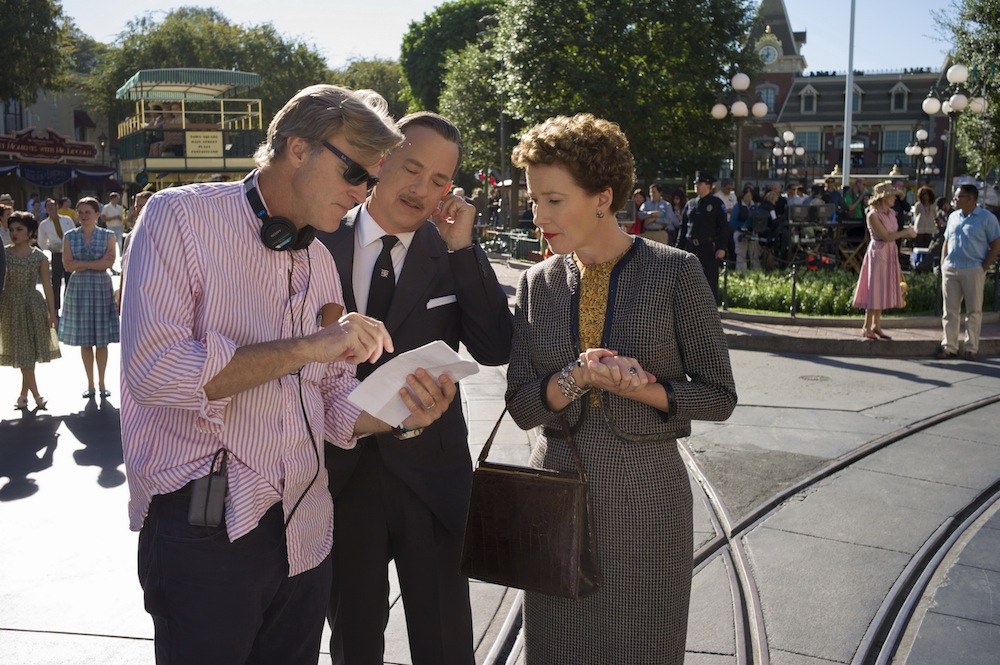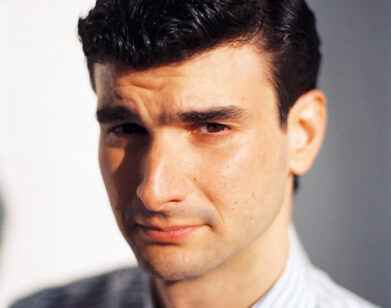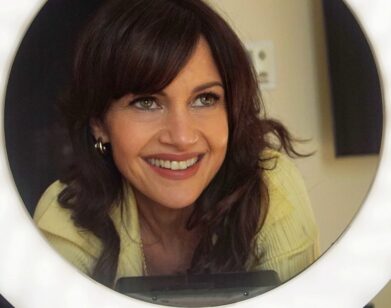The Disney Director

ABOVE: (LEFT TO RIGHT) JOHN LEE HANCOCK, TOM HANKS, AND EMMA THOMPSON ON THE SET OF SAVING MR. BANKS.
“P.L. Travers was full of contradictions,” says director John Lee Hancock of the Mary Poppins author, the subject of his latest film Saving Mr. Banks. “She seemingly didn’t like people paying too much attention to her writing and would say, ‘Mary Poppins just flew in the window.’ But, at the same time, she collected all her papers and gave them to a library in Queensland—she thought that there was some importance to her literary contributions.”
Starring Emma Thompson as Travers, Saving Mr. Banks focuses on how, after a 20-year battle, Walt Disney (Tom Hanks) finally convinced Travers to allow him to make Mary Poppins into a film—and a film with dancing penguins, sunny Sherman Brothers’ songs, and invented tongue-twisters.
The film’s portrayal of Travers is not a flattering one: a misanthrope and a snob, Travers agrees to Disney’s film adaptation of Mary Poppins solely for pecuniary reasons, nit-picks every detail of the script, and frequently threatens to withdraw her permission entirely. “She could be somewhat of an old crone and then a child, just in the wink of an eye” notes Hancock. If today, Walt Disney is thought of as a severe, unpleasant man (though he is not shown as such in the film), he was a teddy-bear love button compared to Travers.
That said, Thompson’s Travers is not exactly an unflattering portrayal either. The film goes to great lengths to explain Travers’ attitude, with flashbacks to her unhappy childhood in rural Australia, marred by the death of her beloved, alcoholic father (played by Colin Farrell), and the suicide attempt of her mother (Ruth Wilson). It does not touch on Travers’ adopted son, whose twin-brother she refused to take in, and downplays the extent to which she despised the final Mary Poppins film.
“We tried to cross-pollinate between four different things: 1906 Australia, the Mary Poppins books, the time P.L. Travers spent in 1961 Los Angeles, and the eventual movie Mary Poppins,” explains Hancock. “Because we were playing with time in such a way, we weren’t looking for an absolute reality.”
Now 57, the Texas-born Hancock began his career as a screenwriter in the early ’90s. As a director, he’s worked on both his own scripts, such as The Alamo (2005) and the Oscar-winning The Blind Side (2009), and those of other writers, such as Mr. Banks and The Rookie.
EMMA BROWN: Saving Mr. Banks was produced by Disney film. Was it strange working on a film about Disney with the Disney studio standing over you?
JOHN LEE HANCOCK: A little bit. I don’t think the script could have ever been developed inside the walls of Disney; I think they would have chopped away at Walt’s character. I was protective of the script and, of course, was concerned that they might come in and chip away at it, but they told me that was not their intention, that they loved the script. They were great partners in this.
BROWN: I heard that they forbade any cigarette smoking.
HANCOCK: No, they didn’t. That’s not true. It was in the script just like it is in the movie: that P.L. Travers comes in and catches Disney and he puts out a cigarette quickly, and says, “I don’t like people seeing me smoking. Hate to encourage bad habits.” Now if I had gone beyond the script and just showed him smoking a whole lot, they may have had an issue with that. But that’s just not Disney. That’s every studio now—if you’ve got smoking in your movie or in your script, you have to justify that. I deal with that at every studio.
BROWN: Walt Disney doesn’t have the best reputation.
HANCOCK: I’ve read everything and you talk to people that love him and people that don’t. He’s like most people I come across. [laughs] They have friends and enemies, especially powerful people. I’m sure the same would be said of Louis B. Mayer or Jack Warner or any of these folks. Thankfully this isn’t a biopic of Walt Disney. I don’t think I would have taken that on.
BROWN: Did you read any of the Mary Poppins’ books as a child?
HANCOCK: I saw the movie, but had not read the books before I read the script. I didn’t know the books and certainly didn’t know the tragic origin story of Mary Poppins in 1906 Australia.
BROWN: Do you think that, had P.L. Travers’ father lived a little longer, their relationship wouldn’t have been as strong? When he dies, she is at an age where she is starting to understand what is going on, but isn’t old enough to be angry at him yet.
HANCOCK: Yeah, and Tom Hanks had talked about that. How there’s an imprint that’s made on a child somewhere between the age of eight and 10 that stays with you the rest of your life. If you’re that incredibly happy kid then that stays with you, and if there’s something traumatic that happens that stays with you. And I kind of agree with that.
BROWN: Do you think the books would still resonate today? Would they have aged well without the movie?
HANCOCK: There’s no doubt that we look at them differently because there was a movie. Every generation comes upon the movie again and then invariably the books have a spike in sales because people want to read more about Mary Poppins.
BROWN: Was anyone attached to the film when you came on board?
HANCOCK: No, no one was attached. Our first conversation about casting we started with Emma and then went to Tom. It was one of those movies where my first choice for each role said yes so I was really fortunate.
BROWN: Did you grow up in an environment where becoming a director was a plausible goal?
HANCOCK: Oh gosh, no. I grew up in Texas City, Texas. I didn’t know anybody who was a director or whose parents or grandparents were directors. I met somebody from a nearby town one time whose father had been to the moon—it was far more likely to be an astronaut than it was to be a writer or a director.
I knew that I loved stories. Looking back on it now, I wrote lots of short stories when I was in elementary school—almost one a day. I got an English degree in college and then went to law school because I didn’t know what else to do. I was a lawyer in Houston, Texas. I started writing plays and screenplays and, after about three years of practicing, I decided I would move to Los Angeles and give it a shot. I had a theater company and starved to death and all the stuff that lots of people do. I didn’t go to film school—my film school was Clint Eastwood. I wrote two movies (A Perfect World, 1993; Midnight in the Garden of Good and Evil, 1997) for Clint and he let me shadow him on the set for both of those and that was an amazing experience. I watched him direct and talked to him a lot about directing and eventually decided I might want to try to direct even though I loved writing. Then The Rookie (2002) came along, which I didn’t write. Mike Rich wrote it. I went in and interviewed for it and got the job. I had been around a while and knew people at the studios so, as much as they were taking a chance with me, they also knew me and felt that I was probably up to it.
BROWN: As a screenwriter, how involved are you when the movie is being filmed? Are you allowed to be on set or is it at the discretion of the director?
HANCOCK: It was absolutely the discretion of the director. And on a Clint Eastwood movie, to be completely fair and honest, there isn’t a lot to do. It’s not as though they’re constant rewrites. Clint, if he likes a script, then that’s the movie he makes. When I’m directing a movie that I haven’t written, I really enjoy having a writer with me all during prep and on set, both with The Rookie and with Saving Mr. Banks I had the writers with me all during prep and all during shoot.
BROWN: Do you rewrite parts of the script as you go along like you might do in a play?
HANCOCK: Yeah. On a daily basis you’re going to change things. When you put something on its feet and you’re in a real place, sometimes what’s on the page doesn’t fit anymore. You also have to be aware; sometimes lines just don’t make sense when you put them on the street. They read perfectly well on the page, but not so much off. So you’re constantly messing with lines during the day or adding lines and that’s why it’s nice to have the writer there, so you’ve got somebody to bounce these things off.
BROWN: Do you approach a script differently as just a director than you do as a writer-director?
HANCOCK: What I try to do as a director, is to interpret the script as a director whether I have written it or not. You have to distance yourself from the writing of the script—try to put your director hat on. That said, if you’ve written it sometimes you have a little more insight into the scenes and what the intention of the scene is and what’s really at work underneath the scene. That’s why I like to have the writer around during prep, so that we can have discussions about what he or she was thinking when they wrote the scene.
BROWN: Is the writer always right?
HANCOCK: No. Oh, god no. [laughs] It’s a director’s medium for better and worse. There are some writers that get that and some that don’t. It becomes a different animal when you have to actually put it on its feet. You have the image of some writers that just couldn’t bear to see something changed from their script and that’s going to happen every day on any movie.
SAVING MR. BANKS IS OUT NOW.






